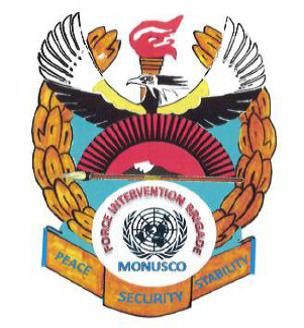Active April 2013 Role Peace Enforcement | ||
 | ||
Country United Nations South Africa Tanzania Malawi | ||
The United Nations Force Intervention Brigade is a military formation which forms part of the United Nations Organization Stabilization Mission in the Democratic Republic of the Congo (MONUSCO). It was authorized by the United Nations Security Council on 28 March 2013 through United Nations Security Council Resolution 2098. The FIB is the first United Nations peacekeeping formation specifically tasked to carry out targeted offensive operations to neutralize armed groups that threaten State authority and civilian security, with or without the Forces Armées de la République Démocratique du Congo (the Congolese Army), against armed groups that threaten peace in the eastern DRC. The brigade is based in North Kivu and is made up of a total of 3,069 peacekeepers. The brigade consists of South African Army, Tanzanian Army, and Malawi Defence Force infantry battalions, Tanzanian artillery, and special forces.
Contents
Authorisation
UN Security Council resolution 2098 (2013) stated that MONUSCO should: '... In support of the authorities of the DRC, on the basis of information collation and analysis, and taking full account of the need to protect civilians and mitigate risk before, during and after any military operation, carry out targeted offensive operations through the Intervention Brigade referred to in paragraph 9 and paragraph 10 above, either unilaterally or jointly with the FARDC, in a robust, highly mobile and versatile manner and in strict compliance with international law, including international humanitarian law and with the human rights due diligence policy on UN-support to non-UN forces (HRDDP), to prevent the expansion of all armed groups, neutralize these groups, and to disarm them in order to contribute to the objective of reducing the threat posed by armed groups on state authority and civilian security in eastern DRC and to make space for stabilization activities.'
The initial, one-year, authorization from the UN Security Council for the Brigade (Security Council resolution 2098 of 28 March 2013) has been renewed annually. Resolution 2211 (2015) extended MONUSCO's mandate along with that of the Brigade to 31 March 2016, and resolution 2277 of 30 March 2016 authorised a further 12 months, to 31 March 2017.
Command
The Force Intervention Brigade was first headed by General James Aloizi Mwakibolwa of Tanzania. Mwakibolwa had had previous experience in the region. He served as commander of the Military Assessment Team of the International Conference on the Great Lakes Region (ICGLR) in October 2012 to assess the military situation in eastern DRC and come up with a concept of operations. Mwakibolwa handed over command to his successor in April 2014.
Brigade Commander
Deputy Brigade Commander
Units
Artillery Battery
Special Forces and Reconnaissance Company
South African infantry battalion
Tanzanian infantry battalion
Malawi infantry battalion
Actions
The FIB was slow to get started. First on the ground was a company of the South African Battalion who were stationed in the Muningi Base just outside Goma. Commanded by Major Vic Vrolik, the company was involved in skirmishes with a group of Mai-Mai rebels on 10 July 2013. They were then under siege in the base as the M23 Rebels shelled Goma and shot artillery, 120mm Mortars and B10 or SPG-9 rockets at the FARDC tanks and soldiers who took shelter behind the UN base.
The FIB was involved in numerous combat engagements during 2013/2014, including:
In December 2014, media reports supported Human Rights Watch' contentions about massacres in the Beni, North Kivu region. Human Rights Watch said that unidentified rebels killed more than 180 civilians in the eastern DRC from September to December 2014. The FIB's non-engagement of these attackers has been severely criticised. The UN head of mission in the DRC, Martin Kobler, conceded that the FARDC has "little appetite" to carry out missions against these perpetrators.
Casualties
Major Khatibu Shaaban Mshindo of the Tanzanian battalion was killed on 28 August 2013 by mortar fire from the M23 militia group near Kibati Hills, just outside Goma. A memorial service was held by members of the brigade to honour his passing. Three Tanzanians and two South Africans were also wounded in the same incident. Private Hugo Barnabas Munga of the Tanzanian battalion died of his wounds in Pretoria on 18 September 2013.
On 27 October 2013, Lieutenant Rajabu Ahmed Mlima, of the Tanzanian Army Special Forces, was killed in action on Govender's Hill, just east of the town of Kiwanja. He was part of the Quick Reaction Force of Task Group Alpha of the Brigade. He was killed during a fire-fight between elements of M23 and the combined South African and Tanzanian QRF.
On 5 May 2015 two Tanzanian peacekeepers were killed in an ambush by what were assumed to be Allied Democratic Force rebels. The attack took place near the village of Kikiki, some 50 km north of Beni in North Kivu province. A later newspaper article raises doubts over the identification of the alleged attackers and suggests the Tanzanians may have been killed by Congolese armed forces, FARDC. The article goes on to suggest that a Malawian soldier killed later (see below) died as a consequence of FARDC inaction.
During November 2015 a Malawian peacekeeper, Staff Sergeant Dyson Mayao, was killed in a rebel attack.
On 18 December 2016 Mai Mai militia attacked a small South African detachment at Butembo, killing Rifleman Moalosi Albert Mokhothu and wounding two other South Africans. Four Mai Mai were killed and two captured.
